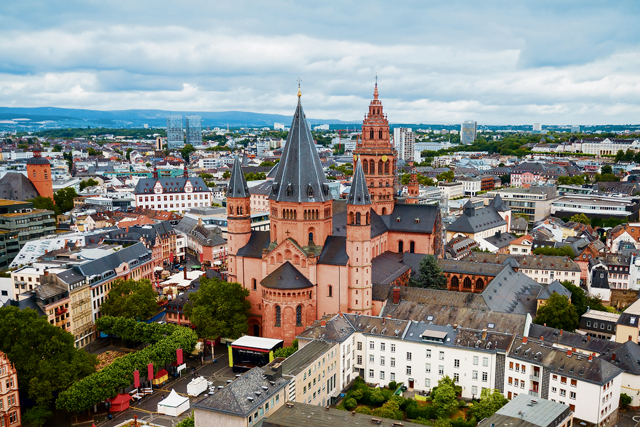
Mainz is not only the capital of Rheinland-Pfalz with its “Landtag” (state parliament) and State Chancellery situated along the banks of the Rhein River. It is also the largest city in the state with a population of 215,000 and can look upon a diverse history.
The city has been historically significant for over 2,000 years with traces of an early Celtic settlement. On their journey conquering northern parts of Europe, the Romans discovered the area and were enchanted by its mild climate and favorable conditions for shipping. They named the settlement Mogontiacum after the Celtic god Mogons and began building a legion camp, the so-called Castrum about 12 B.C.
The civilian population of the small settlement eventually grew and brought with it skilled craftsmen, merchants and wine growers and a large port to carry goods was built directly along the river. The height of the Roman culture lasted for about 200 years until 406 A.D., when Germanic tribes conquered the region. Ruins of the “Römisches Bühnentheater” (stage theater), Roman stones, a Jupiter column, the Isis und Mater Magna-Heiligtum (sanctuary) and a museum for ancient shipping speak of a flourishing Roman culture.
The most prominent edifice in the city is located on the historic market square with a colorful market on weekends. It is said that construction of St. Martin Cathedral began around the year 990 A.D. It has been restored and redesigned on a number of occasions in its over 1,000-year history, but its mainly Romanesque style has remained. The magnificent church has evidenced the crowning of numerous kings and queens and is well worth a visit.
During the High Middle Ages around 1300, the city was called “Goldenes Mainz” and had about 20,000 – 25,000 inhabitants thanks to its flourishing commerce. A century later in 1450 it lost its city rights and was turned into an electoral residence town of little political significance. One of the most prominent characters of the time was Johannes Gutenberg who invented the printing press, mass printed the Luther Bible and thus supported the spread of the Protestant Reformation. A replica of the original press can be visited at the Gutenberg Museum and the university is also named after him.
After he was crowned as “Emperor of the French” in 1804, Napoleon I visited Mainz for the first time, immediately fell in love with the charming city and accounted “Mayence” as one of the 36 most important cities in France, pronouncing it the capital of the Département du Mont-Tonnerre (now Donnersberg). He and his wife enjoyed staying in the lovely city along the river and always resided in the “Deutschhaus” (now the seat of the parliament). The “Grand Rue Napoleon” was built for parades and exists as “Ludwigsstrasse” today. He also had a 600-kilometer-long road built that led from Paris to Mainz, commonly referred to as “Kaiserstrasse” (emperor’s road, now L395/401), which leads through Landstuhl, Kaiserslautern and nearby villages. In addition, his majesty donated the grand bell in the cathedral marked with the inscription “Napoleon the Great.”
Mainz is also known for its “Fastnacht” (carnival) events and a fountain with a multitude of comical figures is located near the cathedral. The Fastnacht slogan is “Mainz bleibt Mainz, wie es singt und lacht!” (Mainz remains Mainz as it sings and laughs). Other places of interest include the old town with semi-timbered buildings, quaint cafés on cobble stone roads, cozy small wine bars and the promenade along the river. There is a castle, Heiliggeist church was turned into a restaurant with a beer garden and the state parliament building overlooks the river promenade.
The city is located precisely on the coordinates 50° 0’ 0.0” N,8° 16’ 16.16” E, very favorable for winemaking, and marked with a stone inscription opposite of the Staatstheater. Mainz is officially one of the seven wine capitals of the world and is situated in the heart of the Rheinhessen viticulture region. The Kupferberg Museum on a hill with the same name, displays the production of sparkling wines since the mid-1850s and is partially situated in underground cellars said to have been established by the Romans.
The Fastnachtsmuseum (carnival museum) and the Landesmuseum (state museum) display artefacts and historical documentation about the city and surroundings. A relaxing river boat ride, a trip over the bridge to Hessen’s capital Wiesbaden may round off your visit.
Don’t miss out on the “Mainzelmännchen” on pedestrian crosswalk lights. The cute comic figures were created in 1963 when the ZDF (Zweites Deutsches Fernsehen, the second national television channel), opened in Mainz-Lerchenberg and short sequences with the adorable characters appear between commercials on German television. A Mainzelbahn (streetcar) decorated with the figures was established in 2016 that takes commuters from Mainz-Lerchenberg directly to the city center.
Join in on one of the many “walk, wine and dine” tours around the city during fall, have breakfast at the colorful farmers’ market in front of the 1,000-year-old Cathedral or stroll under the trees tinged in autumn colors along the banks of the Rhein River. The annual Christmas Market will also take place on the historic market square in front of the cathedral starting late November. For more inspiration visit: www.mainz.de


